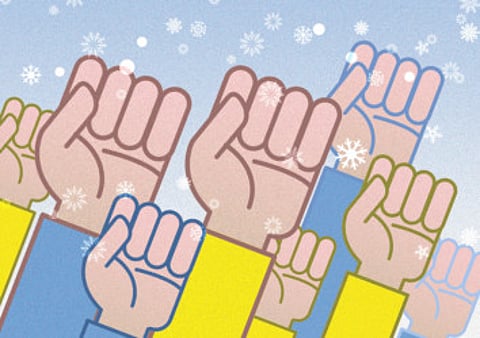Behind Ukraine’s frozen barricades
By his own folly, Yanukovych has galvanised the demonstrators

Ukraine’s winter was harsh enough to stop Hitler’s tanks in 1941, but not the mass protests now sweeping central Kiev. As I write, tens of thousands of people are packing Independence Square — where the current temperature is minus 13 degrees Celsius — for a series of passionate speeches denouncing Ukraine’s leaders.
This unfolding revolution in a great European capital summons images of Paris in 1789 or Vienna in 1848. All around me, volunteers are manning giant snow-clad barricades, made with sacks filled by ice. Squads of protesters are fortifying Ukrainian House, an exhibition centre that became the latest public building to fall into their hands early last Sunday. Behind all this lies an immense logistical effort. Women carry trays of sandwiches and tankards of steaming tea up to the men on the barricades. Well-wishers appear with sacks of winter clothes. An appeal has gone out for people to donate old tyres to be set ablaze on the main barricade across Grushevskogo Street. This feat of organisation explains how the protesters have coped with winter far better than the Wehrmacht.
And if the Arctic chill cannot stop them, what may? Evidence suggests that President Viktor Yanukovych and the opposition leaders are all flying blind. No one has a plan for resolving the confrontation. On the contrary, Yanukovych’s past behaviour may serve as a masterclass for how to turn a drama into a crisis.
The demonstrations began on December 1, after he spurned an agreement with the European Union (EU) in favour of taking $15 billion (Dh55.17 billion) from Russia. Scarred by memories of Soviet oppression, Ukraine is a place where people will risk their lives for the cause of joining the EU. The rallies began as a straightforward pro-European gesture. As the weeks went by, the numbers in Independence Square began to dwindle. Only a fortnight ago, it seemed possible that the demonstrations would simply fade away. Then Yanukovych passed a series of laws banning almost all forms of public protest. At the same time, his police became more heavy-handed. Last Wednesday, they killed at least two demonstrators, shedding blood for the first time in a political cause since Ukraine’s independence in 1991. The combined effect was to transform the demonstrations into a mass, rolling revolution. The people on the barricades became more militant and intransigent. Students waving EU flags are still there, now joined by masked men in camouflage, armed with wooden clubs. These hardline nationalists, ready and equipped for combat, now guard the ramparts. The protesters have two demands: The removal of Yanukovych and the repeal of the security laws. By his own folly, the president has both galvanised the demonstrators and made them more radical. In fairness, his critics have made terrible mistakes as well.
A sensible opposition would have protected itself against divide-and-rule tactics by choosing one representative. Instead, three leaders are negotiating with the president. The most formidable, in a purely physical sense, is Vitali Klitschko, a former heavyweight boxing champion with an 87 per cent knockout rate, who leads the second biggest opposition party in parliament. Alongside his bulky frame sits Arseniy Yatsenyuk, a cerebral former foreign minister who heads the biggest opposition block. The final member of the trio is Oleg Tyagnybok, the leader of a nationalist party. The president has duly taken the chance to play games. Last Saturday, he drove wedges between his three enemies by offering the prime ministership to Yatsenyuk, the deputy premiership to Klitschko — and nothing to Tyagnybok. At first, Yatsenyuk hinted that he might be willing to join a government he reviled, taking “responsibility for Ukraine’s future”. It took him a few more hours to reject the offer. But the signs are that Ukraine’s demonstrations have escalated to the point where no deal between the president and the mainstream opposition could stop them.
Yanukovych has realised the gravity of the situation and has been tossing out concessions like confetti. His hasty offers include “amending” the hated security laws, sacking unpopular ministers, giving powerful jobs to his opponents and granting an amnesty to anyone imprisoned during the unrest.
In fact, he is willing to give the demonstrators just about anything — except what they most want, namely his departure and the junking of the anti-protest laws. After the bloodshed of the past few days, the people on the barricades are unlikely to settle for anything less, regardless of what their triple-headed leadership may say. That leaves two stark possibilities: Either Yanukovych will be driven from office or the protests crushed by force in a massive and bloody showdown. If there is a third way, it will have to be found soon. Where I write behind the barricades, the clock is ticking down to the denouement.
— The Telegraph Group Limited, London, 2014
Sign up for the Daily Briefing
Get the latest news and updates straight to your inbox



